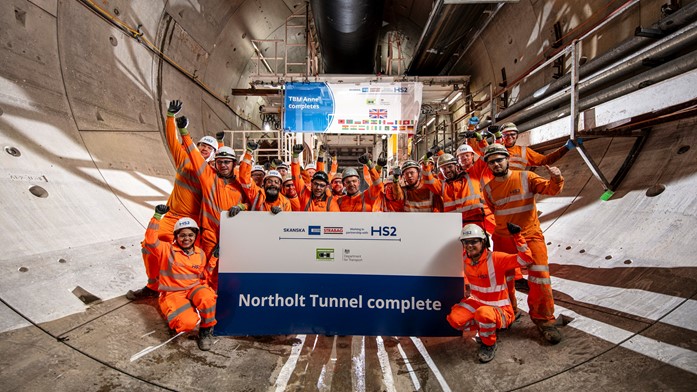Construction of Britain’s new high-speed railway has passed a major milestone with excavation of the 8.4-mile Northolt Tunnel under London.
The fourth of four tunnel boring machines (TBMs) being used to dig the twin-bore tunnel - the second-longest on the HS2 route between London and the West Midlands – has completed its work.

The machine, named Anne, installed the final concrete ring underground before emerging into a vent shaft at Green Park Way in Greenford.
The Northolt Tunnel will take HS2’s new high-speed trains between West Ruislip at the outer edge of the capital and the new Old Oak Common super-hub station in west London.
The Northolt Tunnel, which is 35 metres below ground at its deepest point, has been bored by HS2’s London tunnels contractor Skanska Costain STRABAG JV (SCS JV) using four TBMs. Two built the five-mile western section from West Ruislip and two built the 3.4-mile eastern section from Victoria Road in North Acton.
TBM Anne, named after Lady Anne Byron, has now finished the second bore of the 3.4-mile eastern section completing the tunnel excavation.
All four machines finished their journey at Green Park Way where they are to be lifted out from the underground shaft.
The third TBM, Emily, finished its tunnel bore earlier this month, and will be lifted out of the ground later this summer. The first two machines to arrive, from West Ruislip, were lifted out earlier this year.
Northolt is one of five deep twin-bore tunnels on the 140-mile route and the second longest behind the Chiltern Tunnel, which is 10 miles long.

HS2 is currently undergoing a major reset led by Mark Wild, HS2 chief executive, to make sure the railway can be delivered to the lowest reasonable cost. While this work in ongoing, HS2 continues to make progress on major structures including tunnels and viaducts.
Now the tunnel excavation is complete, the team will continue to build the flat tunnel invert on the base, creating a flat surface where high speed tracks will be laid. There will also be 34 cross passages mined between the two bores of the tunnel which the team continue to build.
The team are also completing five headhouses on the surface of the tunnel. The headhouses cover the ventilation shaft which connects the HS2 tunnel to the open air.

